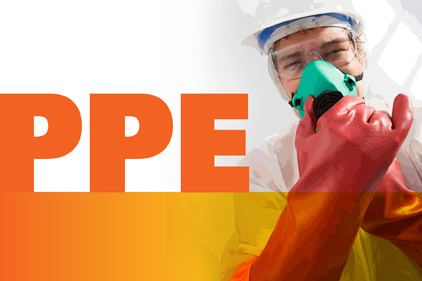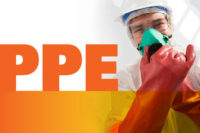When should a respirator be used?

 Source: Canadian Centre for Occupational health and safety www.ccohs.ca
Source: Canadian Centre for Occupational health and safety www.ccohs.ca
Editor’s Note: This Canadian perspective on when to use a respirator replicates many practical recommendations for use of respirators in U.S. workplaces. Be sure to check OSHA’s respiratory protection standard for specific U.S. requirements.
Workers should use respirators for protection from contaminants in the air only if other hazard control methods are not practical or possible under the circumstances. Respirators should not be the first choice for respiratory protection in workplaces. They should only be used:
- when following the "hierarchy of control" is not possible (elimination, substitution, engineering or administrative controls)
- while engineering controls are being installed or repaired
- when emergencies or other temporary situations arise (e.g., maintenance operations)
How should you control respiratory hazards?
Respiratory hazards can include airborne contaminants such as biological contaminants, dusts, mists, fumes, and gases, or oxygen-deficient atmospheres. Note that more than one respiratory hazard can be present at the same time. After elimination and substitution, well designed and maintained engineering controls are the preferred methods of controlling worker exposure to hazardous contaminants in the air. These control methods include:
- mechanical ventilation
- enclosure or isolation of the process or work equipment
- proper control and use of process equipment, and
- process modifications including substitution of less hazardous materials where possible.
Administrative controls may be used in addition to engineering controls. Administrative controls limit workers' exposures by scheduling reduced work times in contaminant areas or by implementing other such work rules. These control measures have many limitations because the hazard is not removed. Administrative controls are not generally favored because they can be difficult to implement, maintain and are not reliable.
What are IDLH considerations
Some types of atmospheres contain concentrations of hazardous substances that place the worker in immediate danger because these concentrations would impair the ability to leave the work area (self rescue) or potentially cause irreversible health effects, including serious injury or death in a matter of minutes.
There are particular conditions that are considered "Immediately Dangerous to Life or Health (IDLH)." These include:
- A known contaminant at a concentration known to be IDLH
- A known contaminant at an unknown concentration with the potential to be IDLH
- An unknown contaminant at an unknown concentration
- An untested confined space
- An oxygen-deficient atmosphere
- Firefighting
- Contaminants at or above 20% of their lower explosive limit (LEL—the concentration at which the gas or vapour could ignite)
To determine IDLH level of a contaminant, consult the NIOSH Pocket Guide to Chemical Hazards.
Adapted from WorkSafe BC Breathe Safer.
Are there some things that you should know before you choose a respirator?
Employers should have a written respirator program that describes the proper procedures for selecting and operating respiratory protective equipment. The correct use of a respirator is just as important as selecting the proper respirator. Parts of the respirator program deal with finding out what hazards are present and how much protection that the workers will need. Other parts should describe how to wear and look after the respirator.
Without a complete respiratory protection program, people will probably not receive the best protection from a respirator even if it is the correct choice for a specific job. A respiratory protection program includes several components such as:
- hazard identification and control
- exposure assessment
- respirator selection
- respirator fit-testing
- training program
- inspection and record keeping
- cleaning and sanitizing respirators
- repairing and maintaining respirators
- proper storage of respirators
- health surveillance
- standard operating procedures (available in written form)
- program evaluation.
A physician should examine the medical and psychological fitness of workers. This should be done before they are assigned to work in areas where respirators may be required. The workers must be physically fit to carry out the work while wearing respiratory equipment. They must also be psychologically comfortable (e.g., not claustrophobic) about wearing respirators.
Workers with beards, long sideburns, or even a two-day stubble may not wear respirators because the hair breaks the seal between the skin and the respirator mask. Wearing eyeglasses would also break the respirator seal. This break means that the respirator mask will "leak" and will not provide the needed respiratory protection. Also, if a worker has facial scars or an acne problem, the facial skin may not be able to form a good seal with a respirator mask.
What are the different classes of respirators?
The two main types are air-purifying respirators (APRs) and supplied-air respirators (SARs).
Air-purifying respirators can remove contaminants in the air that you breathe by filtering out particulates (e.g., dusts, metal fumes, mists, etc.). Other APRs purify air by adsorbing gases or vapors on a sorbent (adsorbing material) in a cartridge or cannister. They are tight-fitting and are available in several forms:
- mouth bit respirator (fits in the mouth and comes with a nose clip to hold nostrils closed - for escape purposes only)
- quarter-mask (covering the nose and mouth),
- half-face mask (covering the face from the nose to below the chin), or
- full facepiece (covering the face from above the eyes to below the chin).
- Respirators with a full facepiece also protect the eyes from exposure to irritating chemicals.
- Supplied-air respirators (SARs) supply clean air from a compressed air tank or through an air line. This air is not from the work room area. The air supplied in tanks or from compressors must meet certain standards for purity and moisture content (e.g., CSA Standard Z180.1-00 (R2010): Compressed Breathing Air and Systems). (See OSHA respiratory protection standard for U.S. workplace requirements.)
Supplied-air respirators may have either tight-fitting or loose-fitting respiratory inlets. Respirators with tight-fitting respiratory inlets have half or full facepieces. Types with loose-fitting respiratory inlets can be hoods or helmets that cover the head and neck, or loose-fitting facepieces with rubber or fabric side shields. These are supplied with air through airlines.
Examples of these classes of respirators include:
- Air-purifying respirators (APRs):
- particulate respirators (previously called dust, fume, and mist respirators or masks),
- chemical cartridge respirators that can have a combination of chemical cartridges, along with a dust prefilter: this combination provides protection against different kinds of contaminants in the air
- gas masks (contain more adsorbent than cartridge-type respirators and can provide a higher level of protection than chemical cartridge respirators)
- powered air-purifying respirators (PAPRs).
- Supplied-air respirators (SARs):
- self-contained breathing apparatus (SCBA),
- airline supplied-air respirators,
- protective suits that totally encapsulate the wearer's body and incorporate a life-support system.
There are some combinations of airline respirators and SCBAs that allow workers to work for extended periods in oxygen-deficient areas or where there are airborne toxic contaminants. The auxiliary or backup SCBA source allows the worker to escape with an emergency source of air if the airline source fails.
There are also combination air-purifying and atmosphere supplying respirators. These will offer worker protection if the supplied-air system fails, if the appropriate air-purifier units are selected. These cannot be used in oxygen-deficient areas or where the air concentration of a contaminant exceeds the IDLH level (i.e., immediately dangerous to life or health).
Since filters capture particles, caution must be exercised to always check that these filters are not clogged as it makes it harder for air to pass through and increase the likelihood of contaminated air entering the mask. Cartridges can also become "full" or saturated. It will stop working and "breakthrough" will occur – this term means that the gases or vapors will leak through the cartridge. Both cartridges and filters must be replaced on a regular basis by using the manufacturer’s recommendations (usually determined by using warning properties or end-of-service indicators).
How do you select the right respirator?
Choosing a respirator is a complicated matter. Experienced safety professionals or occupational hygienists, who are familiar with the actual workplace environment, are the staff who should select the proper respirator. They can choose a suitable respirator only after they have evaluated all relevant factors. This includes considering the limitations of each class of respirator.
Before the proper respirator can be selected for a job, be sure you have already:
- identified the respiratory hazard.
- evaluated the hazard.
- considered whether engineering controls are feasible.
- There are too many types of situations to cover them all fully here. However, the following questions represent part of "decision logic" that a safety professional or occupational hygienist can use when selecting a respirator:
- Is it to be used in firefighting or emergencies?
- Is it to be used in oxygen-deficient atmospheres (less than 18% oxygen in air; some jurisdictions say below 19.5%)?
- What is the nature of the hazard (chemical properties, concentration in the air, warning properties)?
- Is there more than one contaminant (i.e. a mixture or more than one chemical is present)?
- Is the airborne contaminant a gas, vapor or particulate (mist, dust or fume)?
- Are the airborne levels below or above the exposure limit, or are they above levels that could be immediately dangerous to life or health?
- What are the health effects of the airborne contaminant (carcinogenic, potentially lethal, irritating to eyes, absorbed through the skin)?
- What are the characteristics of the operation or the process (e.g., hot temperature, confined space)?
- What activities will the worker be doing while wearing the respirator (e.g., strenuous work)?
- How long will the worker need to wear the respirator?
- Does the selected respirator fit the worker properly?
- Where is the nearest safe area that has respirable air?
- Use the safety data sheet for guidance on requirements of the particular respiratory hazard.
Looking for a reprint of this article?
From high-res PDFs to custom plaques, order your copy today!





